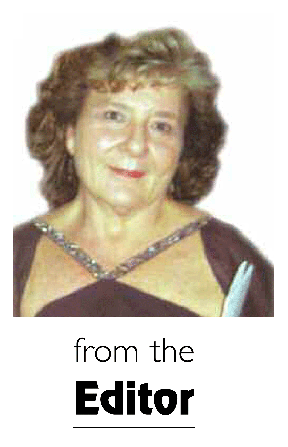
Volume XVII, Issue 30 # July 23 - July 29, 2009 |
 |
from the Editor
Eating Locally — with Reservations
The feast slows down when fish are on the menu
Once again this week, my kitchen table is a cornucopia of bounty from my local farmers’ market: eight kinds of tomatoes, baby beets, plums, farm eggs, sunflowers.
A Chesapeake Bay rockfish would be the perfect centerpiece to tonight’s summer dinner of deviled eggs; baby beets with their own greens; and sliced heirloom tomatoes topped with my own basil and my favorite vintage California olive oil.
And my husband would love to catch me that rockfish.
We’d both love to eat it, but we can’t.
We’ve already eaten our July allotment of rockfish.
The contamination of many local fish is an unappetizing footnote to the Eat Local stories we’ve been writing and reading.
Twenty-five meals a year is Maryland’s recommended limit on rockfish, aka striped bass, caught in the Chesapeake and its tributaries. That’s about two a month, and we ate our two promptly after a successful Independence Day of fishing off Flag Harbor in Calvert County.
If husband Bill prefers bottomfishing, we still might go hungry if he catches white perch. Each of us only gets 30 servings a year of that delectable fish if it’s caught in Herring Bay. As that’s our local Bay, Bill often fishes there. Or 28 if he were fishing the Magothy. From the Rhode and West rivers, 32. From the Severn, 34. And from the South, 48.
On all those rivers, we’d have to do our math. Because, if we want to avoid filling up on toxic PCBs, we don’t get to eat our limit of each and every fish. We’ve got to mix and match while staying under the total.
PCBs are one of the legacies of the chemical era. Polychlorinated biphenyls were manufactured in the United States starting in 1929 and became popular in insulating, pesticides, flame retardants and many other products because of their inflammability and chemical stability. The sole American manufacturer of PCBs was Monsanto, the same company bringing us genetically modified farming and, ironically, a raft of commercials these days about all they’re doing to promote clean water.
PCBs were banned in the U.S. in 1979, but they remain a ubiquitous problem because they continue to leak from electrical transformers and other old products and don’t easily break down in the environment. They move continuously among the air, water and soil and often show up in pristine lands thousands of miles from where they started.
They also wind up in fish, in highest concentrations in predators like rockfish and bluefish that devour many littler fish.
If we were catching our fish in coastal waters, we’d be able to eat even less. In June, the Atlantic Coastal States issued an advisory recommending that the general population should eat no more than one meal (eight ounces per adult and three ounces per child) per month of striped bass, and one meal every other month of bluefish. Women in their childbearing years and children under three are advised to skip those fish all together.
The Environmental Protection Agency says this about potential health effects: “PCBs have been demonstrated to cause cancer, as well as a variety of other adverse health effects on the immune system, reproductive system, nervous system and endocrine system.”
I’m still hungry for fish, so I’m sending Bill out for spot. The species is unrestricted, except in the South River, where we’re allowed 50 meals per year. If he turns up the Patuxent River, we can eat all the white perch he can catch, too.